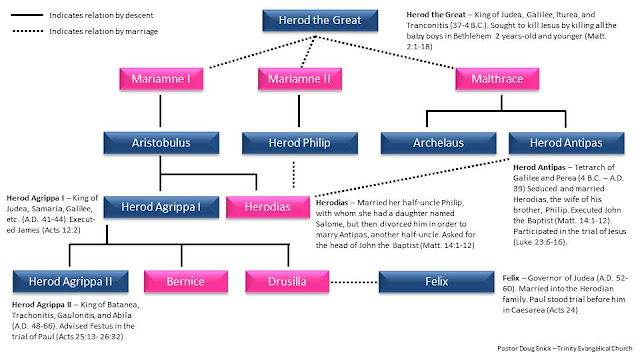Keeping up with the Herodians
When reading the New Testament, it can be
difficult to follow who’s who in the family of Herod. Here’s a brief overview of the Herodian
dynasty, at least of those members who play a prominent role in the Gospels and
the book of Acts.
The most famous member of
the dynasty is its founder, Herod the Great.
He’s not called “Great” because he was good or wise or just, but because
he was an ambitious builder. The ruins of his many projects can still be seen all over Israel. It was Herod the Great who attempted to put
Jesus to death as a baby by ordering all the male children in Bethlehem under
two years of age to be killed.
He died a few months after our
Lord was born and his dominion was divided among three of his sons. He had more than three, but these are they who
inherited his kingdom: Archelaus and Herod Antipas, brothers from the
same mother (Malthrace), and Herod Philip, a brother from another mother
(Mariamne II).
Archelaus is mentioned in
Scripture just in passing (Matt. 2:22). Herod Antipas is known to us in the
Gospels for having a brief part to play in the trial of Jesus. The part was inconsequential enough that only
Luke mentions it (Luke 23:6-16). Antipas is better known to us as the one who—through the conniving of his wife—ordered the execution of John the Baptist.
Who was she, and how does she fit into the picture? Another one of
Herod’s wives (he had five in all) bore him a son named Aristobulus. He in
turn fathered a daughter named Herodias. At first she was married to her
half-uncle Philip, but ended up divorcing him in order to marry Antipas (also a
half-uncle). It was a very sordid,
messy, scandalous series of events. And
this was what John rebuked at the cost of his head.
If we look in more detail at
the line of Aristobulus, we’ll find that in addition to his daughter Herodias,
he also had a son named Herod Agrippa. He’s the one who in Acts 12 executed
the apostle James and sought to kill Peter also.
Herod Agrippa in turn had a son
named Agrippa the II, and two daughters, named Bernice and Drusilla. It’s this Herod—Agrippa II—who heard Paul’s
defense in Acts 26, along with his sister Bernice. The two of them were rumored
to be living together in an incestuous relationship. There are some grounds to believe the rumor
to be true.
Bernice eventually met and fell
in love with the Roman general Titus who led the imperial armies in the
conquest of Jerusalem in the final stages of the war. She and Titus married in
Rome after the war, but he divorced her when the people of Rome objected to his
having an eastern queen. Ever since the famous episode with Mark Antony and
Cleopatra a hundred years earlier, the Romans took a dim view of their
high-ranking officials taking eastern wives, especially eastern queens.
The name of Agrippa’s other
sister, Drusilla, is mentioned in Acts 24, where she is introduced to us as the
wife of the Roman governor, Felix. And you think today’s political alliances
are complicated!
So in the Gospels and Acts, we
have four generations of Herods. Herod the Great was the first; Agrippa II was
the last. When Agrippa II died the world could finally say good-bye and
good-riddance to this notorious ruling family.


Comments